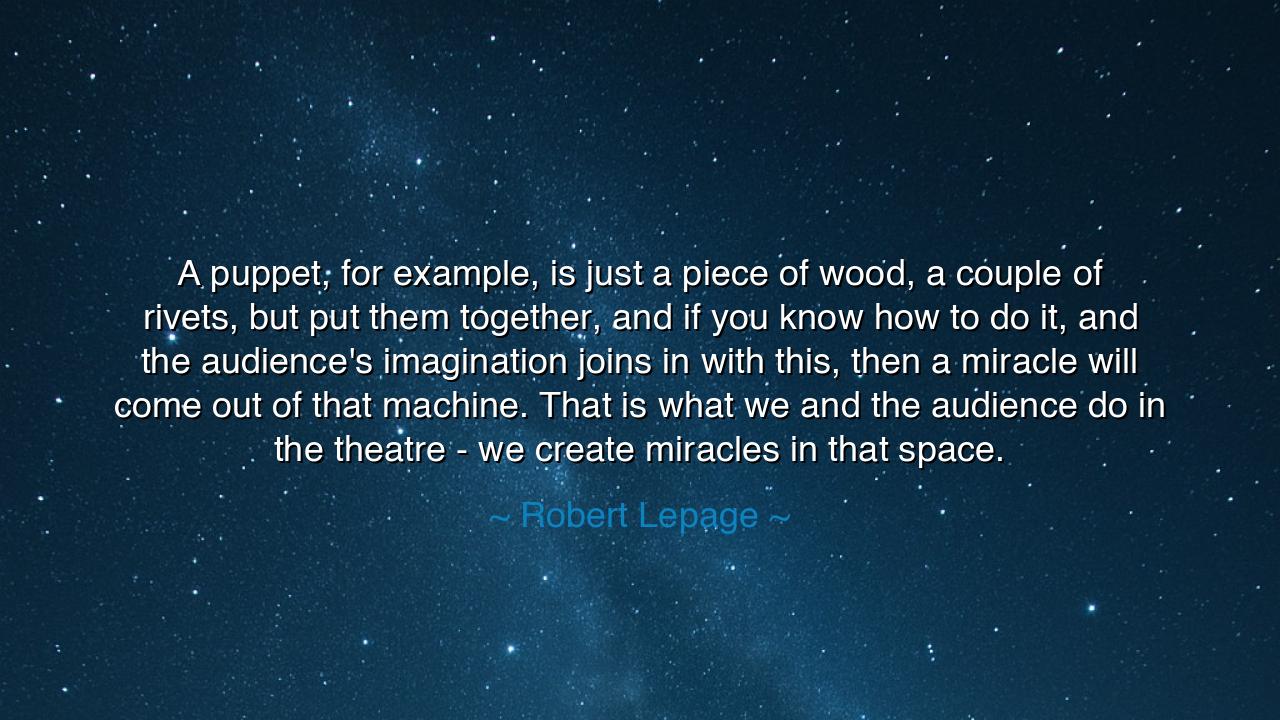
A puppet, for example, is just a piece of wood, a couple of
A puppet, for example, is just a piece of wood, a couple of rivets, but put them together, and if you know how to do it, and the audience's imagination joins in with this, then a miracle will come out of that machine. That is what we and the audience do in the theatre - we create miracles in that space.






The Sacred Art of Illusion: How Miracles Are Made in the Theatre
Hear now, O listener, the words of Robert Lepage, the visionary of stage and imagination: “A puppet, for example, is just a piece of wood, a couple of rivets, but put them together, and if you know how to do it, and the audience’s imagination joins in with this, then a miracle will come out of that machine. That is what we and the audience do in the theatre — we create miracles in that space.” These are not merely the reflections of an artist but the revelations of a creator of worlds, one who understands the ancient secret of transformation — that even lifeless things can breathe and move when touched by the union of craft and imagination.
Lepage speaks of the puppet, that humble creature of wood and joint, lifeless until guided by the unseen hand. Yet when the puppeteer moves with purpose, and when the audience’s imagination ignites, the inanimate becomes alive, and the ordinary is transfigured into wonder. This, he says, is a miracle — not in the divine sense of defying nature, but in the human sense of transcending it. The puppet, in truth, is all of us: we are the wood, the rivets, the raw material. What gives us life, what gives art its soul, is the shared act of belief between creator and witness, between the hand that moves and the eyes that see.
From the beginning of time, this mystery has been known to the storytellers of old. When the bards of Greece sang of gods and heroes, when the elders of the tribes told tales by firelight, there were no machines, no grand stages — only voices, gestures, and the imagination of those who listened. Yet mountains rose, oceans raged, and spirits walked among them. The miracle was the same: through the power of story, the unseen became visible. In every true act of creation, it is not the material that matters, but the spirit that animates it.
Consider the tale of Jim Henson, who crafted his Muppets from felt and thread. To the untrained eye, they were simple things — foam and cloth. But when he gave them voice, when his hand breathed life into them, and when audiences dared to believe, Kermit and his companions became alive in hearts across the world. The miracle was not in the materials, nor even in Henson’s craft alone, but in the shared act of imaginative faith between performer and viewer. This is what Lepage calls the miracle of the theatre — a sacred collaboration between the maker and the dreamer.
In the theatre, this sacred exchange becomes a form of alchemy. A stage is only wood and curtain, but when the lights dim and the story begins, something greater descends upon that space. The audience ceases to be mere spectators; they become co-creators. Their laughter, their tears, their silence — these are the invisible hands that move the world of the play. It is through this communion that art becomes spirit and illusion becomes truth. As Lepage teaches, we create miracles not by force, but by participation — by surrendering ourselves to the act of belief.
And yet, this wisdom stretches far beyond the theatre. For all of life is a kind of stage, and every human act of creation depends upon the same partnership. A teacher speaking to her students, a leader stirring hearts, a parent reading to a child — each of these is a form of performance, an invocation of imagination. The tools may be humble — a book, a voice, a gesture — but when joined with intention and belief, they awaken something greater. The miracle happens whenever human beings unite their will and wonder to make meaning out of matter.
So take this teaching into your heart, O reader of ages: Do not despise the small or the simple. The puppet is wood, the brush is hair, the word is mere sound — yet within them lies the seed of transformation. When touched by imagination, the ordinary becomes extraordinary. Believe, and others will believe with you. Create, and others will join your vision. Whether you build, sing, teach, or love, remember that the miracle is never in the thing itself — it is in the spirit you bring and the faith others share.
Thus, as Robert Lepage reminds us, every stage — whether in theatre or in life — is holy ground. Upon it, mortals and imagination together can perform the oldest magic: to make the lifeless live, the silent speak, and the unseen shine before the eyes of all. For in that moment of shared belief, the miracle is complete.






AAdministratorAdministrator
Welcome, honored guests. Please leave a comment, we will respond soon